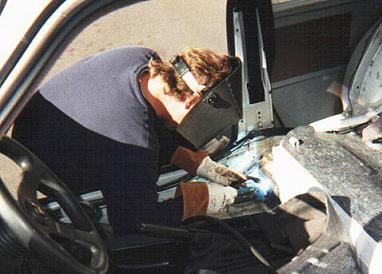 This is my friend Sean McLean welding
in one of the baseplates for the main hoop of the roll bar. Sean
and I have been friends since Junior High. We used to race BMX in
the mid 70's (along with Jay Morris of Ground Control - small world).
This is my friend Sean McLean welding
in one of the baseplates for the main hoop of the roll bar. Sean
and I have been friends since Junior High. We used to race BMX in
the mid 70's (along with Jay Morris of Ground Control - small world).
Sean has become an extremely accomplished race car fabricator. He worked for 3 years with Tom Gloy on the Trans Am car driven by Ron Fellows. Then for the last couple of years Sean was working for Griggs Racing building high performance Mustang parts. However, he now works for Huffaker Racing where he is back to building Trans Am cars. By his recollection, he has installed about 200 roll bars and cages in all manner of vehicles. The baseplates for my 88 M3 roll bar were made from several pieces of 1/8" steel plate. The baseplates were welded to the chassis using MIG (metal inert gas) - otherwise known as "sputter welding." The rest of the roll bar was TIG welded (Tungsten inert gas). MIG welding makes a real mess. Sparks go flying everywhere. Care must be taken not to burn any of the interior pieces. Also, all of the metal sparks have to be vacuumed up afterwards. TIG welding is very clean in comparison. The only problem is heat, but even that is less than with MIG welding. TIG welding can even be performed right next to the headliner. The trick is to slide a scrap of sheet aluminum between the roll bar tube and the roof headliner - and then put a moist clean rag on the backside of the aluminum sheet. That way the heat produced by welding goes into evaporating water instead of burning your headliner! The reason that MIG welding is preferable for the baseplates is that it is less susceptible to contamination and impurities. It is hard to get the chassis "clean" enough to allow for a good TIG weld. |
 Here is a
close-up of the passenger side baseplate for the main hoop that Sean was
welding on above. Note that the baseplate is actually made of three
separate pieces of plate, one of which is bent down over the depression
in the floor-pan. Unfortunately, the E30 M3 does not present an opportunity
to weld the baseplates directly to the frame rails. But this is the
next best thing. The last thing you want is for the baseplates to
"oil can" and flex the floor pan to the point of failure! Note that
all of the sound deadening mat was scraped away prior to welding.
Those germans make some pretty impressive sound deadening materials.
They are very tough to remove.
Here is a
close-up of the passenger side baseplate for the main hoop that Sean was
welding on above. Note that the baseplate is actually made of three
separate pieces of plate, one of which is bent down over the depression
in the floor-pan. Unfortunately, the E30 M3 does not present an opportunity
to weld the baseplates directly to the frame rails. But this is the
next best thing. The last thing you want is for the baseplates to
"oil can" and flex the floor pan to the point of failure! Note that
all of the sound deadening mat was scraped away prior to welding.
Those germans make some pretty impressive sound deadening materials.
They are very tough to remove.
|